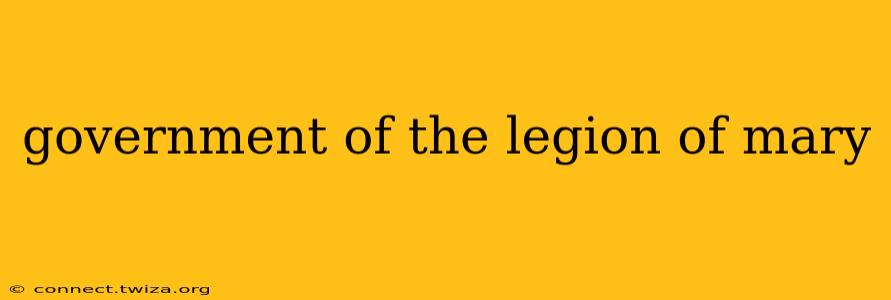The Legion of Mary, a lay Catholic organization dedicated to the evangelization of the world, operates under a specific governance structure. Understanding this hierarchical system is crucial to grasping the Legion's global reach and its effectiveness in carrying out its mission. This article will delve into the government of the Legion of Mary, exploring its various levels and the spiritual principles that underpin its organization.
What is the governing body of the Legion of Mary?
The highest governing body of the Legion of Mary is the Concilium Legionis Mariae (C.L.M.), headquartered in Dublin, Ireland. This international body oversees the entire organization, providing guidance, setting policy, and ensuring uniformity in the Legion's activities worldwide. The C.L.M. doesn't directly manage individual praesidia (the basic unit of the Legion), but it provides a framework and support system for their operation. Its decisions are based on the spiritual principles established by the founder, Frank Duff, and approved by the Catholic Church.
What are the different levels of the Legion of Mary's structure?
The Legion's structure operates on a hierarchical basis, with various levels of authority and responsibility:
-
Praesidium: This is the foundational unit, a small group of Legionaries who meet regularly for prayer, spiritual formation, and the carrying out of assigned apostolic works. Each praesidium operates within a defined area, often a parish or neighborhood.
-
Comitium: A Comitium is a grouping of several praesidia within a larger geographical area, such as a city or diocese. It provides support and coordination to the praesidia under its jurisdiction.
-
Regia: At the next level, several Comitia are grouped together to form a Regia, typically covering a larger region or even a country. The Regia offers oversight and guidance to its constituent Comitia.
-
Concilium Legionis Mariae (C.L.M.): As previously mentioned, the C.L.M. is the highest governing body, overseeing the entire worldwide organization of the Legion of Mary.
How does the Legion of Mary ensure uniformity in its practices worldwide?
The Legion's uniformity stems from its adherence to the established spiritual principles and operational guidelines set by the C.L.M. These guidelines cover various aspects of the Legion's activities, including prayer practices, apostolic work, and the internal structure. Regular communication and reporting between the different levels of the organization facilitate the implementation and maintenance of these standards. The Handbook of the Legion of Mary serves as a crucial document outlining these principles and practices.
What are the spiritual principles guiding the government of the Legion of Mary?
The Legion of Mary's government is deeply rooted in its spiritual foundation. These principles are central to its organization and operation:
-
Marian devotion: The Legion's name reflects its profound devotion to Mary, the Mother of God. Mary's example of faith, obedience, and service serves as a guiding light for all Legionaries.
-
Spiritual Warfare: The Legion views its apostolic work as a spiritual battle against evil. Spiritual exercises and prayer are integral parts of its approach.
-
The importance of prayer and sacrifice: Personal prayer and self-sacrifice are considered essential elements of a Legionary's life.
-
Teamwork and collaboration: The hierarchical structure facilitates teamwork and collaboration, ensuring that the Legion's activities are effectively carried out.
Who leads the Legion of Mary?
While the C.L.M. is the overall governing body, the day-to-day leadership of the Legion at each level is vested in various roles, including Spiritual Directors, Presidents, and other officers within the praesidia, Comitia, and Regia. These individuals are elected or appointed according to the Legion's rules and guidelines.
The Legion of Mary's structure, while hierarchical, is designed to foster collaboration and service. Its spiritual foundation ensures that its activities remain rooted in Catholic faith and practice. The organization's worldwide reach and influence demonstrate the effectiveness of its government and the dedication of its members.
